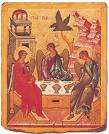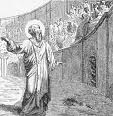| Next | Previous | Index | Tellout Home |
29. Justin Martyr Worship
Early Church Meeting
 Justin Martyr worship describes gatherings in the Early Church and is the oldest (non-New Testament) record of how they conducted early Christian worship. In "The First Apology," "On the day called Sunday, a meeting for all takes place, in whichever city or town one lives. The "Memoirs of the Apostles" (the Gospels), or the "Writings of the Prophets," are read if there is time. When the reader has finished, the president, in a sermon, calls us all to imitate these good things. Then we all stand and pray." ✞
Justin Martyr worship describes gatherings in the Early Church and is the oldest (non-New Testament) record of how they conducted early Christian worship. In "The First Apology," "On the day called Sunday, a meeting for all takes place, in whichever city or town one lives. The "Memoirs of the Apostles" (the Gospels), or the "Writings of the Prophets," are read if there is time. When the reader has finished, the president, in a sermon, calls us all to imitate these good things. Then we all stand and pray." ✞
Household of Faith Worship
 Justin Martyr described the leader of worship as "president" because non-Christians might not have understood particular words such as "bishop" or "presbyter." John Foster, in "The First Advance - Church History 1: AD 29-500," wrote, "The three items mentioned, reading of Scripture, a sermon based on the reading, and prayers (which were said standing), followed the custom of the synagogue. Justin Martyr described the New Testament lesson as being from the Gospels (and placed this first), and the Old Testament lesson as an alternative, from the Prophets." For further light on Early Church worship, see also Justin Martyr. ✞
Justin Martyr described the leader of worship as "president" because non-Christians might not have understood particular words such as "bishop" or "presbyter." John Foster, in "The First Advance - Church History 1: AD 29-500," wrote, "The three items mentioned, reading of Scripture, a sermon based on the reading, and prayers (which were said standing), followed the custom of the synagogue. Justin Martyr described the New Testament lesson as being from the Gospels (and placed this first), and the Old Testament lesson as an alternative, from the Prophets." For further light on Early Church worship, see also Justin Martyr. ✞
Corinthian Christian Worship
 Corinthian Christian worship emphasized choirs, particularly in the dining room, who sang hymns rapt with enthusiasm. During Corinthian Christian worship, the people sat according to 1 Corinthians 14.30, "if a revelation comes to someone sitting down, the first speaker should stop." Those eating meals in the temple reclined as in 1 Corinthians 8.10, "For if someone with a weak conscience sees you, with all your knowledge, eating in an idol's temple, won't that person be emboldened to eat food sacrificed to idols?" Any latecomer, according to the pagan novelist Lucian's Symposium (125-180 AD), is offered a place to sit (which he declines) though this is questionable. The significant numbers must have meant that Christians did not have enough space for all to recline during the meal. ✞
Corinthian Christian worship emphasized choirs, particularly in the dining room, who sang hymns rapt with enthusiasm. During Corinthian Christian worship, the people sat according to 1 Corinthians 14.30, "if a revelation comes to someone sitting down, the first speaker should stop." Those eating meals in the temple reclined as in 1 Corinthians 8.10, "For if someone with a weak conscience sees you, with all your knowledge, eating in an idol's temple, won't that person be emboldened to eat food sacrificed to idols?" Any latecomer, according to the pagan novelist Lucian's Symposium (125-180 AD), is offered a place to sit (which he declines) though this is questionable. The significant numbers must have meant that Christians did not have enough space for all to recline during the meal. ✞
Choir Sang Hymns
 Standing in the dining room, they formed choirs, one line of men and one of the women, singing hymns to God, sometimes antiphonally, keeping time with hands and feet rapt with enthusiasm. Then they mixed and became a single choir, a copy of that by the Red Sea, where a command of God made the sea a source of salvation to one party and resulted in punishment for the other. The ancient choir sang hymns of thanksgiving to God their Savior, the men led by the prophet Moses, the women by the prophetess Miriam. I wonder whether we have an equivalent in our Sunday worship to the praise of Moses and Miriam? ✞
Standing in the dining room, they formed choirs, one line of men and one of the women, singing hymns to God, sometimes antiphonally, keeping time with hands and feet rapt with enthusiasm. Then they mixed and became a single choir, a copy of that by the Red Sea, where a command of God made the sea a source of salvation to one party and resulted in punishment for the other. The ancient choir sang hymns of thanksgiving to God their Savior, the men led by the prophet Moses, the women by the prophetess Miriam. I wonder whether we have an equivalent in our Sunday worship to the praise of Moses and Miriam? ✞
Bread Salt Water
 Bread, salt, and water are essential elements in the worship and the lives of the Household of Faith. Bread seasoned with salt is a traditional way of honoring guests. Carolyn Osiek and David L. Balch tell us in "Families in the New Testament World - Households and House Churches" that there is silence while the attendants stand ready for their ministry. The president gives an exposition of Holy Scriptures and then rises to sing a new or old hymn to God. All the others take their turn, listening in silence except for the closing refrains, when all, men and women, lift their voices. ✞
Bread, salt, and water are essential elements in the worship and the lives of the Household of Faith. Bread seasoned with salt is a traditional way of honoring guests. Carolyn Osiek and David L. Balch tell us in "Families in the New Testament World - Households and House Churches" that there is silence while the attendants stand ready for their ministry. The president gives an exposition of Holy Scriptures and then rises to sing a new or old hymn to God. All the others take their turn, listening in silence except for the closing refrains, when all, men and women, lift their voices. ✞
Seasoned with Salt
After the hymns, the young men bring in portable tables with bread, salt, and water, although there is neither wine nor meat. While most ate leavened bread seasoned with salt mixed with hyssop, their superiors received the simplest and purest food, unleavened bread with salt unmixed. Interestingly, in some Slavic, European, and Middle Eastern cultures, bread and salt are together a welcome greeting. On all pleasant occasions salt was given, in greetings, at weddings, house warming parties, and childbirth celebrations. The most expensive thing was salt. After supper, there was an all-night vigil. Some elements of this New Testament worship have come down to us today? ✞
Real House Church
 Worship in a real house church in an ordinary home in the early centuries varied in different parts of the Roman Empire. Most of these Christian house churches met in just regular homes? Vivid descriptions have come down to us, of a preacher at Smyrna, of the Eucharist in Rome, and Baptism in Carthage. We must not think, however, that Christians did things in the same way everywhere. We are reading about actual scenes in these house churches, meeting real people, and catching something of their spirit. We must not imagine the Early Church as altogether good. The samples we are looking at are good ones, but we later come upon problems, failures, mistakes, and divisions. As Christ himself said in Matthew 13.24-26, "The kingdom of heaven is like a man who sowed good seed in his field. But while everyone was sleeping, his enemy came and sowed weeds among the wheat and went away. When the wheat sprouted and formed heads, then the weeds also appeared." ✞
Worship in a real house church in an ordinary home in the early centuries varied in different parts of the Roman Empire. Most of these Christian house churches met in just regular homes? Vivid descriptions have come down to us, of a preacher at Smyrna, of the Eucharist in Rome, and Baptism in Carthage. We must not think, however, that Christians did things in the same way everywhere. We are reading about actual scenes in these house churches, meeting real people, and catching something of their spirit. We must not imagine the Early Church as altogether good. The samples we are looking at are good ones, but we later come upon problems, failures, mistakes, and divisions. As Christ himself said in Matthew 13.24-26, "The kingdom of heaven is like a man who sowed good seed in his field. But while everyone was sleeping, his enemy came and sowed weeds among the wheat and went away. When the wheat sprouted and formed heads, then the weeds also appeared." ✞
"Justin Martyr Worship"
by Ron Meacock © 2021
| ^Top Page | Next | Previous |